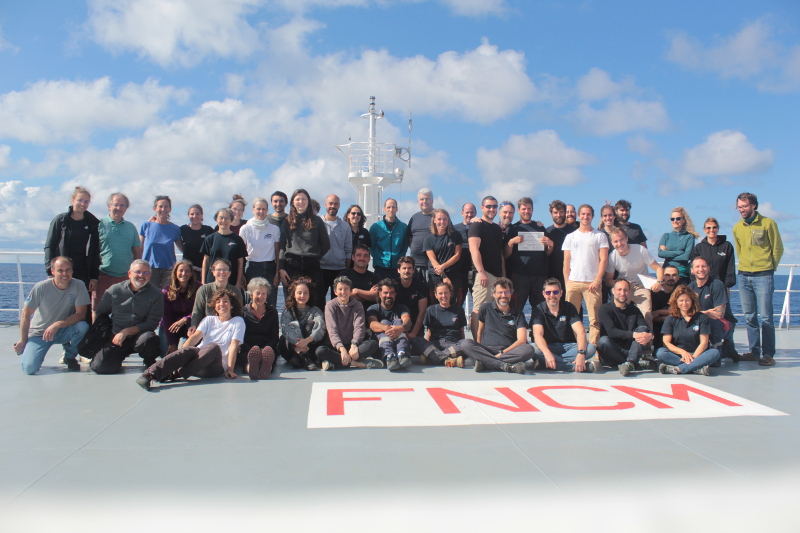BioSWOT-Med cruise : A successful campaign under SWOT swath in the NW Mediterranean Sea
The BioSWOT-Med campaign ended on Sunday 14th May after four weeks of navigation sampling an area characterized by a persistent front between modified Atlantic waters of different ages about 100 km north-est of Menorca Island (Spain) under one of SWOT swaths. The BioSWOT-Med scientific team is fully satisfied by the data that were acquired and thanks the Captain and the crew of R/V L’Atalante which allowed a great campaign despite challenging weather conditions.

The BioSWOT-Med team and the R/V L’Atalante crew
By BioSWOT-Med team
Today, Sunday 14th of May, after 4 weeks of navigation, we are finally back at La Seyne-sur-Mer. Our BIOSWOT-Med campaing is now concluded, with the full satisfaction of the scientific team.
The choice for our operation zone finally went for an area about 100 km north-east of Menorca island (Spain), along one of the swath of the SWOT satellite, launched few months ago. Just at the beginning of our cruise, a very welcomed surprise has been the availability of preliminary, near real-time images of sea surface height from SWOT. These images, produced for us by the SWOT Project (CNES, NASA, and JPL) have revolutionized our strategy, because they allowed us to pinpoint the position and shape of fronts or vortices with an unprecedented precision of few km.
We also had the luck of having several cloud-free days just before the cruise, that corresponded to a sequence of several high-resolution surface chlorophyll maps from the OLCI-Sentinel 3 sensor. Combined with our land-based satellite analysis with the “SPASSO” toolbox developed in the framework of the SWOT-AdAC consortium, SWOT and Sentinel-3 drew for us the physical and biological seascape of our region.
We thus headed to a persistent front between modified Atlantic waters of different ages about 100 km north-east of Menorca. We spent three weeks there and explored the fine-scale ocean dynamics and its impact on plankton diversity. Although ideal for our scientific questions, this region is challenging in terms of navigation. Strong northerly winds, Tramontane and Mistral, contribute to the transformation of local water masses, but at the same time may create challenging conditions for shipboard operations.
All together, we were able to carry out all the vertical profiles envisaged, and even more than expected casts for CTD-rosette, and for FFADCP and VMP (respectively, vertical velocities and turbulence).
A large number of plankton nets was performed and plankton was also studied in mesocosms (Waipapa Taumata Rau University of Auckland).
Six ARGO profiling floats by OGS (Italy) and LEFE-GMMC (France) were deployed. These instruments are still drifting in the study area and providing very useful insights of the evolution of post-cruise conditions.
In order to validate the new observations of the SWOT satellite and for studying the details of the ocean currents, a large number of surface drifters were released: 10 SVPs and 10 CODEs (OGS, Italy), 20 CARTHE (ISMAR-CNR), 15 eOdyn (SWOT-AdAC international consortium), two Spotter (LOPS) and 8 additional SVPs from SCRIPPS Inst. (US). A prototype surface drifter equipped with a set of biogeochemical sensors (ISMAR-CNR, Rome) was deployed and recovered before leaving the study area.
One of our prototype system designed for measuring the vertical velocities, the Vertical Velocity Profiler (VVP), went unfortunately lost, during the first station, probably due to a malfunction of the instrument and/or the positioning system. The MIO scientific team therefore improved the second prototype unit, that performed many vertical profiles.
The Moving Vessel Profiler (MVP) (GENAVIR and MIO, France) performed more than 1400 high-resolution multiparameter profiles.
All the pumped water samples worked well, thanks also to the help and technical support provided by the crew, who significantly improved the scientists’ equipment with parts manufactured on board!
Cytometer and spectrometer acquisitions on the thermosalinometer water inlet also worked perfectly and the ADCP and single-beam sounder acquisitions were fully satisfactory.
More than 500 000 liters of seawater were sampled and analyzed for their biogeochemical properties.
In conclusion, the scientists benefited from a well-equipped and performing vessel. The Captain of R/V L’Atalante Gilles Ferrand and his competent, enthusiastic, and accommodating crew, deserve our thanks for their work, which allowed a great campaign!
Learn more about the campaign through the BioSWOT-Med timeline
More Information

